|
|
Fast Ethernet Interface Processor (FEIP) Installation and Configuration
Product Numbers: CX-FEIP-1TX=, CX-FEIP-2TX=, CX-FEIP-1FX=, CX-FEIP-2FX=
This configuration note provides instructions for installing the Fast Ethernet Interface Processor (FEIP) in Cisco 7000 family routers: Cisco 7000, Cisco 7010, Cisco 7505, Cisco 7507 and Cisco 7513. Included are upgrade instructions with specific steps for upgrading the FEIP microcode by downloading a new image. Also included are basic configuration steps and examples for configuring the Fast Ethernet interfaces on a new FEIP, and steps for attaching appropriate interface cables.
This publication includes the following sections:
![]()
The Cisco Internetwork Operating System (Cisco IOS) software running your router contains extensive features and functionality. The effective use of many of many of these features is easier if you have more information at hand. For additional information on configuring and maintaining the Cisco 7000 family routers and FEIP, the following documentation resources are available to you:
cs-rep@cisco.com
. You can also refer to the Cisco Information Packet that shipped with your router.
The FEIP provides up to two IEEE 802.3u 100BASE-T ports on two separate Fast Ethernet port adapters. The 100BASE-T interfaces are mounted on port adapters that attach to the FEIP motherboard. Each port adapter has two 100BASE-T interfaces: one RJ-45 and one Media Independent Interface (MII) connection. Only one connection can be used per port adapter. The FEIP uses a Reduced Instructions Set Computing (RISC), Mips 4600 processor for high performance, and has an internal operating frequency of 100 megahertz (MHz) and a 50-MHz system bus interface. The FEIP has 8-megabytes (MB) of dynamic random access memory (DRAM). Each 100BASE-T port on the FEIP has an RJ-45 connector to attach to Category 5 unshielded twisted-pair (UTP) for 100BASE-TX, and a media independent interface (MII) connector that permits connection through external transceivers to multimode fiber for 100BASE-FX, or to Category 3, 4 and 5 UTP or shielded twisted-pair (STP) for 100BASE-T4 physical media. Both full-duplex (FDX) and half-duplex (HDX) are supported. The FEIP is also interoperable with the Catalyst 5000 100BASE-T switch.
IEEE 802.3u 100BASE-T Overview
The term Ethernet is commonly used for all carrier sense multiple access/collision detection (CSMA/CD), local area networks (LANs) that generally conform to Ethernet specifications, including IEEE 802.3u. IEEE 802.3u is well suited to applications where a local communication medium must carry sporadic, occasionally heavy traffic at high peak data rates.
Stations on a CSMA/CD LAN can access the network at any time. Before sending data, the station listens to the network to see if it is already in use. If it is, the station waits until the network is not in use, then transmits; this is half-duplex operation. A collision occurs when two stations listen for network traffic, hear none, and transmit very close to simultaneously. When this happens, both transmissions are damaged, and the stations must retransmit them. The stations detect the collision and use backoff algorithms to determine when they should retransmit. Both Ethernet and IEEE 802.3u are broadcast networks, which means that all stations see all transmissions. Each station must examine received frames to determine whether it is the intended destination and, if it is, pass the frame to a higher protocol layer for processing. IEEE 802.3u specifies the following different physical layers for 100BASE-T:
Each physical layer protocol has a name that summarizes it characteristics in the format speed/signaling method/segment length where speed is the LAN speed in megabits per second (Mbps), signalling method is the signalling method used (either baseband or broadband), and segment length is typically the maximum length between stations in meters. Therefore, 100BASE-T specifies a 100-Mbps, baseband LAN, with maximum network segments of 100 meters (or 400 meters for 100BASE-FX).
What Is the Cisco 7000 Series?
The Cisco 7000 series consists of the Cisco 7000 (see Figure 1) and Cisco 7010 (see Figure 2) routers. The FEIP will operate in Cisco 7000 series routers with a Route Processor (RP) and Switch Processor (SP) (or Silicon Switch Processor [SSP]) installed, or with a 7000 Series Route Switch Processor (RSP7000) and 7000 Series Chassis Interface (RSP7000CI) installed.
In the Cisco 7000 series routers, network interfaces reside on modular interface processors, including the FEIP, which provide a direct connection between external networks and the high-speed CxBus in the Cisco 7000 series. Chassis slots 0 through 4 are reserved for interface processors, including the FEIP.
Figure 1 : Cisco 7000 with RSP7000 and RSP7000CI Installed, Interface Processor End
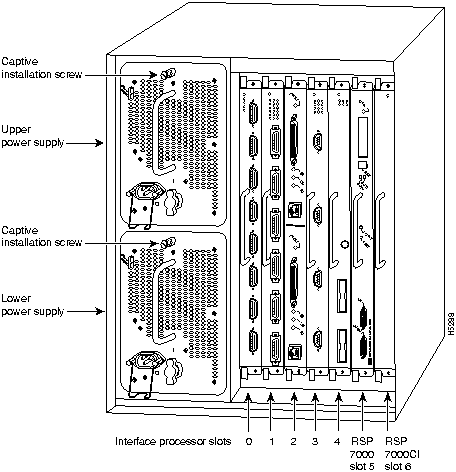
In the Cisco 7010 (see Figure 2), chassis slots 0 through 2 are reserved for interface processors, including the FEIP.
Figure 2 : Cisco 7010 with RSP7000 and RSP7000CI Installed, Interface Processor End
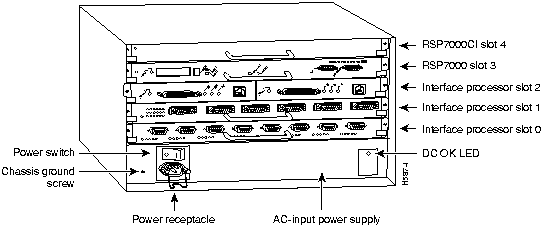
What Is the Cisco 7500 Series?
The Cisco 7500 series consists of the Cisco 7505, Cisco 7507, and Cisco 7513 routers. The FEIP will operate in the Cisco 7500 series routers. Network interfaces reside on modular interface processors, including the FEIP, which provide a direct connection between external networks and the high-speed CyBus in the Cisco 7500 series.
Figure 3, Figure 4, and Figure 5 show the rear of the Cisco 7500 series routers: the five-slot Cisco 7505, the seven-slot Cisco 7507, and the thirteen-slot Cisco 7513, respectively.
In the Cisco 7505 (see Figure 3), one slot (4) is reserved for the Route Switch Processor (RSP1), which contains the system processor and performs packet switching functions. Slots 0 through 3 are for interface processors, including the FEIP.
Figure 3 : Cisco 7505, Interface Processor End

Figure 4 shows the rear of the seven-slot Cisco 7507 router. In the Cisco 7507, up to two slots (2 and 3) are reserved for the Route Switch Processor (RSP2), which contains the system processor and performs packet switching functions. Slots 0 and 1 and 4 through 6 are for interface processors, including the FEIP.
Figure 4 : Cisco 7507, Interface Processor End
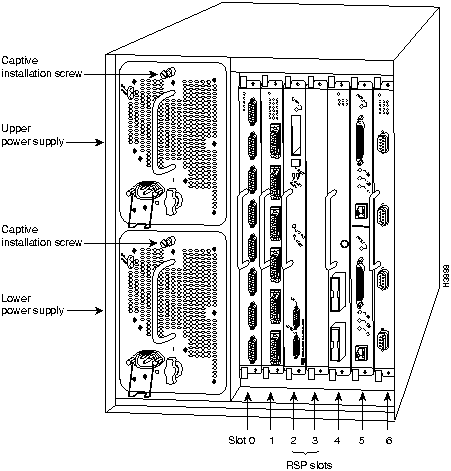
Figure 5 shows the rear of the Cisco 7513 with two AC-input power supplies installed. Two slots (6 and 7) are reserved for the second generation Route Switch Processor (RSP2), which contains the system processor and performs packet switching functions. Slots 0 through 5 and 8 through 12 are for interface processors, including the FEIP.
Figure 5 : Cisco 7513, Interface Processor End
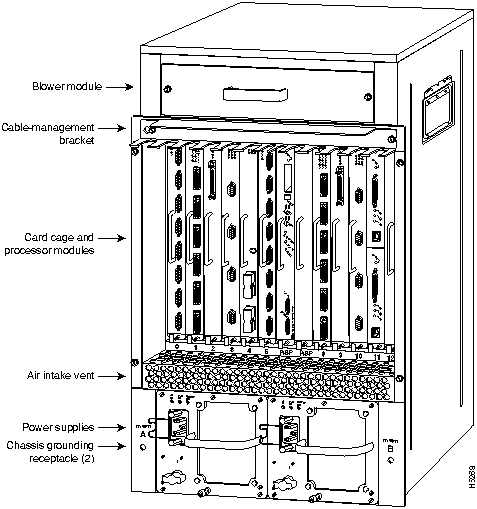
The FEIP and all other interface processors support online insertion and removal (OIR), which allows you to install or remove an FEIP while the system is operating, without shutting down system power.
The FEIP provides up to two 100-Mbps, 100BASE-TX or 100BASE-FX, Fast Ethernet interfaces. (Figure 6 shows a two-port 100BASE-TX FEIP.) The interfaces on an FEIP can both be configured at 100 Mbps, half duplex or full duplex, for a maximum aggregate bandwidth of 200 Mbps. The FEIP firmware (microcode), which contains card-specific software instructions, resides in a Flash memory device in socket location U37. (See Figure 6.) For pinouts, refer to the section "Fast Ethernet Receptacles, Cables, and Pinouts" on page 12. The standard dynamic random access memory (DRAM) size for the FEIP is 8 megabytes (MB). You can install FEIPs in any available interface processor slots.
Figure 6 : Fast Ethernet Interface Processor (Horizontal Orientation Shown)
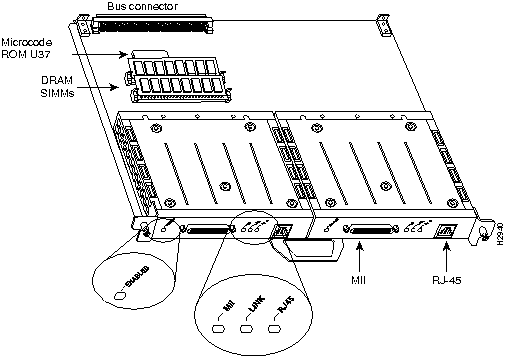
The FEIP is available in the following four fixed configurations. (An equal sign [=] indicates the FEIP is available as a spare part.)
The FEIP configured with 1FE-TX or 1FE-FX port adapters provides a 100-Mbps, 100BASE-T Fast Ethernet (FE) interface. Each Fast Ethernet port on the 1FE-TX port adapter has an RJ-45 connector to attach to Category 5 unshielded twisted-pair (UTP) for 100BASE-TX, and a MII connector that permits connection through external transceivers to multimode fiber for 100BASE-FX, or to Category 3, 4, and 5 UTP or shielded twisted-pair (STP) for 100BASE-T4 physical media.
Each Fast Ethernet port on the 1FE-FX port adapter has an SC-type fiber-optic connector for 100BASE-FX, and an MII connector that permits connection through external transceivers to multimode fiber for 100BASE-FX, or to Category 3, 4, and 5 UTP or shielded twisted-pair (STP) for 100BASE-T4 physical media. The 1FE-TX and 1FE-FX port adapters are shown in Figure 7 and Figure 8.
Figure 7 : 1FE-TX Port Adapter, Faceplate View

Figure 8 : 1FE-FX Port Adapter, Faceplate View

The FEIP contains the enabled LED, standard on all interface processors, and a bank of three status LEDs for the ports. After system initialization, the enabled LED goes on to indicate that the FEIP has been enabled for operation. (The LEDs are shown in Figure 9.) The following conditions must be met before the enabled LED goes on:
If any of these conditions is not met, or if the initialization fails for other reasons, the enabled LED does not go on.
The bank of three LEDs indicates the following:
Either the MII LED or the RJ-45 (or FIBER) LED should be on at any one time; never both.
Figure 9 : LEDs for the FEIP (Partial Faceplate View)

Fast Ethernet Receptacles, Cables, and Pinouts
The two interface receptacles on the FEIP port adapter are a single MII, 40-pin, D-shell type, and a single RJ-45. You can use either one or the other. Only one receptacle can be used at one time. Each connection supports IEEE 802.3u interfaces compliant with the 100BASE-FX and 100BASE-TX standards.
The RJ-45 connection does not require an external transceiver. The MII connection requires an external physical sublayer (PHY) and an external transceiver. Figure 10 shows the RJ-45 cable connectors. RJ-45 cables are not available from Cisco Systems, but are available from commercial cable vendors. Table 1 lists the pinouts and signals for the RJ-45 connectors.
Figure 10 : RJ-45 Connections (Connector and Plug)

Table 1 : RJ-45 Connector Pinout
Depending on your RJ-45 interface cabling requirements, use the pinouts in Figure 11 and Figure 12.
Figure 11 : Straight-Through Cable Pinout (Connecting FEIP RJ-45 Interface to a Hub or Repeater)
Figure 12 : Crossover Cable Pinout (RJ-45 Connections Between Hubs and Repeaters)
Figure 13 shows the duplex SC connector (one required for both transmit and receive), and Figure 14 shows the simplex SC connector (two required, one for each transmit and receive) used for 1FE-FX optical-fiber connections. These multimode optical-fiber cables are commercially available, and they are not available from Cisco Systems.
Figure 13 : 1FE-FX Duplex SC Connector
Figure 14 : 1FE-FX Simplex SC Connector
Depending on the type of media you use between the MII connection on the port adapter and your switch or hub, the network side of your 100BASE-T transceiver should be appropriately equipped: with SC-type or ST-type connectors (for optical fiber), BNC connectors, and so forth. Figure 15 shows the pin orientation of the female MII connector on the port adapter.
The MII receptacle uses 2-56 screw-type locks, called jackscrews (shown in Figure 15), to secure the cable or transceiver to the MII port. MII cables and transceivers have knurled thumbscrews (screws you can tighten with your fingers) that you fasten to the jackscrews on the FEIP MII connector. Use the jackscrews to provide strain relief for your MII cable. (The RJ-45 modular plug has strain relief functionality incorporated into the design of its standard plastic connector.) Figure 15 shows the MII connector.
Figure 15 : MII Connection (Female)
Table 2 lists the MII connector pinout and signals. MII cables are available commercially.
Table 2 : MII Connector Pinout
Table 3 lists the cabling specifications for 100-Mbps transmission over UTP, STP, and fiber-optic cables. Table 4 lists IEEE 802.3u physical characteristics for 100BASE-FX and 100BASE-TX.
Table 3 : Specifications and Connection Limits for 100-Mbps Transmission
Table 4 : IEEE 802.3u Physical Characteristics
The FEIP microcode provides card-specific software instructions. (See the section "Software and Hardware Prerequisites" page 16.) A Flash memory device in socket U37 of the FEIP contains the default microcode boot image. The router supports downloadable microcode, which enables you to upgrade microcode versions by downloading new microcode images, storing them in Flash memory, and instructing the system to load an image from Flash instead of the default ROM image (the RP runs software from ROM; the RSP1 runs software from Flash only). You can store multiple images for an interface type and, with a configuration command, instruct the system to load any one of them or the default ROM image. All interfaces of the same type (FEIP, HIP, and so on) will load the same microcode image, either from the default ROM image or from a single image stored in Flash. Although multiple microcode versions for a specific interface type can be stored concurrently in Flash, only one image can load at startup. The show controllers cbus command displays the currently loaded and running microcode version for the SP and for each interface processor. The show configuration EXEC command shows the current system instructions for loading microcode at startup. Software and interface processor microcode images are carefully optimized and bundled to work together. Overriding the bundle can result in system incompatibilities. We recommend that you use the microcode included in the software bundle. For a complete description of microcode and downloading procedures, refer to the section "Upgrading Microcode" on page 35.
This section provides software and hardware prerequisites, a list of parts and tools you will need to perform the installation, and safety and ESD-prevention guidelines to help you to avoid injury and damage to the equipment. It also provides a detailed description of the OIR function to help you perform online installation successfully and avoid error message and system restarts. If you are installing a new FEIP, be sure to review the equipment descriptions and distance limitations in the section "Fast Ethernet Receptacles, Cables, and Pinouts" on page 12.
Software and Hardware Prerequisites
The FEIP with 100BASE-TX port adapters operates with the CxBus and CyBus and requires that the host Cisco 7000 series router is running Cisco Internetwork Operating System (Cisco IOS) Release 10.3(5), or later, and the host Cisco 7500 series routers are running Cisco IOS Release 10.3(6) or later.
The FEIP with 100BASE-FX port adapters operates with the CxBus and CyBus and requires that the host Cisco 7000 family router is running Cisco Internetwork Operating System (IOS) Release 10.3(13), or later, Release 11.0(10), or later, or Release 11.1(5), or later.
Each FEIP is a fixed configuration; therefore, individual port adapters are not available as spare parts and are not field-replaceable or removable. The entire FEIP assembly is treated as a field-replaceable unit (FRU). Do not attempt to remove an FEIP's port adapter and replace it with another. Do not attempt to simultaneously operate 100BASE-TX and 100BASE-FX port adapters on the same FEIP.
You need the following tools and parts to install or upgrade an FEIP. If you need additional equipment, contact a service representative for ordering information.
Following are safety guidelines that you should follow when working with any equipment that connects to electrical power or telephone wiring.
Follow these basic guidelines when working with any electrical equipment:
Use the following guidelines when working with any equipment that is connected to telephone wiring or to other network cabling:
Preventing Electrostatic Discharge Damage
Electrostatic discharge (ESD) damage, which can occur when electronic cards or components are improperly handled, results in complete or intermittent failures. A processor module comprises a printed circuit board that is fixed in a metal carrier. Electromagnetic interference (EMI) shielding, connectors, and a handle are integral components of the carrier. Although the metal carrier helps to protect the board from ESD, use a preventive antistatic strap whenever handling a processor module.
Following are guidelines for preventing ESD damage:
Online Insertion and Removal---An Overview
The OIR feature allows you to remove and replace interface processors while the system is operating; you do not need to notify the software or shut down the system power.
Each interface processor contains a male connector with which it connects to the system backplane. Each card (male) connector comprises a set of tiered pins, in three lengths. The pins send specific signals to the system as they make contact with the backplane. The system assesses the signals it receives and the order in which it receives them to determine what event is occurring and what task it needs to perform, such as reinitializing new interfaces or shutting down removed ones.
For example, when inserting an interface processor, the longest pins make contact with the backplane first, and the shortest pins make contact last. The system recognizes the signals and the sequence in which it receives them. The system expects to receive signals from the individual pins in this logical sequence, and the ejector levers help to ensure that the pins mate in this sequence.
When you remove or insert an interface processor, the backplane pins send signals to notify the system, which then performs as follows:
The system brings on line only interfaces that match the current configuration and were previously configured as up; all others require that you configure them with the configure command.
OIR functionality enables you to add, remove, or replace interface processors with the system online, which provides a method that is seamless to end users on the network, maintains all routing information, and ensures session preservation.
The function of the ejector levers (see Figure 16) is to align and seat the card connectors in the backplane. Failure to use the ejector levers and insert the interface processor properly can disrupt the order in which the pins make contact with the backplane. Follow the FEIP installation and removal instructions carefully, and review the following examples of incorrect insertion practices and results:
It is also important to use the ejector levers when removing an interface processor to ensure that the board connector pins disconnect from the backplane in the logical sequence expected by the system. Any interface processor that is only partially connected to the backplane can hang the bus. Detailed steps for correctly performing OIR are included with the following procedures for installing and removing the FEIP.
The following sections describe the procedures for removing or installing an FEIP in the Cisco 7000 series routers or a Cisco 7500 series routers. The functionality is the same for each router model; therefore, the term the chassis will be used except where specific model issues arise. The OIR function allows you to install and remove an FEIP without first shutting down the system; however, you must follow the instructions carefully. Failure to insert the FEIP properly can cause system error messages indicating a board failure. For a complete description of OIR, refer to the section "Online Insertion and Removal---An Overview" on page 18.
Each unused interface processor slot contains an interface processor filler (which is an interface processor carrier without an interface board) to keep dust out of the chassis and to maintain proper air flow through the interface processor compartment. If you are installing a new FEIP that is not a replacement, you must first remove the interface processor filler from an unused slot; proceed to the next section "Removing an Interface Processor Filler." If you are replacing an FEIP or upgrading the microcode EPROM on an FEIP, proceed to the section "Removing an FEIP" on page 22.
Removing an Interface Processor Filler
Select an unused interface processor slot for the new FEIP and remove the interface processor filler as follows:
To help prevent dust and contaminants from entering the chassis, do not leave the interface processor slot open. Immediately proceed to the section "Installing an FEIP" on page 23.
The FEIP supports OIR; therefore, you need not shut down the interface or the system power when removing an FEIP. If you are replacing a failed FEIP, remove the existing board first, then replace the new FEIP in the same slot. Figure 17 shows proper handling of an interface processor during installation.
To remove an FEIP, follow these steps:
Figure 17 : Handling Processor Modules for Installation and Removal (Horizontal Orientation Shown)
The FEIP slides into the open interface processor slot and connects directly to the backplane. The interface processors are keyed to guide pins on the backplane, so the FEIP can be installed only in an interface processor slot. Figure 16 shows the functional details of inserting an interface processor and using the ejector levers. Figure 17 shows proper handling of an interface processor during installation.
Follow these steps to install an FEIP:
Attaching FE Port Adapter Interface Cables
On a single FE port adapter, you can use either the RJ-45 (or SC for 1FE-FX) connection or the MII connection. If you have two FE port adapters on your FEIP, you can use the RJ-45 (or SC for 1FE-FX) connection on one port adapter and the MII connection on the other port adapter.
Connect RJ-45, SC (1FE-FX), or MII cables as follows:
Figure 18 : Connecting 1FE-TX MII or RJ-45 Cables (Horizontal Orientation)
Figure 19 : Connecting 1FE-FX MII or SC Cables (Horizontal Orientation)
Figure 20 : Attaching the Ferrite Bead around the RJ-45 Cable
This completes the FEIP installation. Proceed to the section "Checking the Installation."
After you install the FEIP and connect cables, verify the installation by observing the LED states and the console display. When the system has reinitialized all interfaces, the enabled LED on the FEIP and on all interface processors should go on. One or the other of the MII and RJ-45 LEDs should be on, depending on your connection, and the link LED should be on if the FEIP is receiving a carrier signal from the network.
The console screen will also display a message as the system discovers each interface during its reinitialization.
When you remove and replace interface processors, the system provides status messages on the console screen. The messages are for information only.
The following sample display shows the events logged by the system as an FEIP was removed from slot 1; the system then reinitialized the remaining interface processors and marked as down the Fast Ethernet interfaces on the FEIP that was removed from slot 2. When a new FEIP was reinserted, the system automatically brought up the interfaces that were up when the FEIP was removed.
When a new FEIP is inserted or when an FEIP is moved to a new slot, the system recognizes the new Ethernet interfaces, but leaves them in a shutdown state until you configure them and change their state to up with the configure command.
The following example display shows the events logged by the system as a new FEIP is inserted in slot 3:
Verify that the FEIP is installed correctly as follows:
If an error message is displayed on the console terminal, refer to the System Error Messages publication for error message definitions. If you experience other problems that you are unable to solve, contact a service representative for assistance.
This completes the FEIP installation. If you installed a new FEIP or if you installed a replacement FEIP with an additional port, you must now configure the new interface as described in the following section.
If you installed a new FEIP or if you want to change the configuration of an existing interface, you must enter the Configuration mode. If you replaced an FEIP that was previously configured, the system will recognize the new FEIP interfaces and bring them up in their existing configuration.
After you verify that the new FEIP is installed correctly (the enabled LED goes on), use the privileged-level configure command to configure the new interfaces. Be prepared with the information you will need, such as the following:
For a summary of the configuration options available and instructions for configuring the interfaces on the FEIP, and depending on the Cisco IOS running on your system, refer to the appropriate software configuration publications listed in the section "If You Need More Information" on page 2.
Using the EXEC Command Interpreter
Before you use the configure command, you must enter the privileged level of the EXEC command interpreter with the enable command. The system will prompt you for a password if one has been set.
The system prompt for the privileged level ends with a pound sign (#) instead of an angle bracket (>). At the console terminal, enter the privileged level as follows:
Selecting Chassis Slot, Port Adapter, and Fast Ethernet Interface Port Numbers
In the router, physical port addresses specify the actual physical location of each interface port on the router interface processor end. (See Figure 21.) For the FEIP, the address is composed of a three-part number in the format slot//port adapter/port number, as follows:
Interface ports maintain the same address regardless of whether other interface processors are installed or removed. However, when you move an interface processor to a different slot, the first number in the address changes to reflect the new slot number. For example, on the one-port FEIP in chassis slot 3 (shown in Figure 21), the address of the Fast Ethernet port is 3/0/0: chassis slot 3, port adapter slot 0, and interface 0. If you remove the FEIP from chassis slot 3 and install it in slot 2, the address of the Fast Ethernet port becomes 2/0/0.
Figure 21 : Interface Port Numbers Examples (Cisco 7505 Shown)
You can identify interface ports by physically checking the slot/port location on the rear of the router or by using software commands to display information about a specific interface or all interfaces in the router. To display information about every interface, use the show interfaces command (interfaces is plural) without variables. To display information about a specific interface, use the show interfaces command with the interface type and port address in the format show interfaces [type slot/port]. If you abbreviate the command (sho int) and do not include variables, the system interprets the command as show interfaces and displays the status of all interfaces.
Following is an example of how the show interfaces command displays status information (including the physical slot and port address) for each interface in the router. In this example, most of the status information for each interface is omitted.
You can also use arguments such as the interface type (fastethernet, and so forth) and the port number (slot/port) to display information about a specific interface only. The following example of the show interfaces fastethernet command shows information specific to the FEIP port in chassis slot 3:
For complete command descriptions and instructions, refer to the software configuration publications listed in the section "If You Need More Information" on page 2.
Using the configure Command---Descriptions and Examples
Following are descriptions and examples of the commands for configuring the FEIP interface 3/0/0 (chassis slot 3, port adapter 0, interface port 0). Configuring other FEIP interfaces is identical except that the chassis slot and port adapter slot numbers will change accordingly.
Descriptions are limited to fields that are relevant for establishing and verifying the configuration. After configuring the new FEIP interface, use show commands to display the status of the new interface or all interfaces, or to verify changes you have made.
Depending on the requirements for your system configuration and the protocols you plan to route on the interface, you might also need to enter other configuration subcommands. For complete descriptions of configuration subcommands and the configuration options available for Fast Ethernet interfaces, refer to the publications listed in the section "If You Need More Information" on page 2.
FEIP half-duplex operation is the default. To change to full-duplex operation, use the following series of commands:
Using the show interfaces fastethernet 3/0/0 command, you can see that the Fast Ethernet interface is now configured for full-duplex operation, as follows:
To return the interface to half-duplex operation, use the no full-duplex configuration command as follows:
Using the show interfaces fastethernet 3/0/0 command, you can see that the Fast Ethernet interface is now configured for half-duplex operation, as follows:
The RJ-45 connection is the default for 1FE-TX (or SC for 1FE-FX). To change to an MII connection and then verify it, use the following series of commands, including the media-type configuration command:
Use the media-type 100 configuration command to return the interface to its default state for RJ-45 or SC (fiber-optic) connections.
The show version command displays the configuration of the system hardware (the number of each interface processor type installed), the software version, the names and sources of configuration files, and the boot images. Following is an example of the show version command used with a Cisco 7000 series system:
The show controllers cbus command displays the internal status of each interface processor, including the slot location, the card hardware version, and the currently running microcode version. It also lists each interface (port) on each interface processor including the logical interface number, interface type, physical (slot/port adapter/port) address, and hardware (station address) of each interface. This example shows an FEIP installed in interface processor slot 3:
The show configuration command displays the contents of the system configuration file stored in NVRAM. This file should reflect all new configuration changes you made and wrote to memory with the copy running-config startup-config or write memory commands, depending on the version of Cisco IOS running on your router.
The show protocols command displays the global (system-wide) and interface-specific status of any configured Level 3 protocol.
Verifying FEIP Status Using show Commands
The following procedure describes how to use the show commands to verify that the new interfaces are configured correctly:
If the interface is down and you configured it as up, or if the displays indicate that the hardware is not functioning properly, ensure that the network interface is properly connected and terminated. If you still have problems bringing the interface up, contact a service representative for assistance.
This completes the configuration procedure for new FEIP interfaces.
Following is general information on upgrading microcode, translated safety warnings, and obtaining technical information and assistance.
The Cisco 7000 series and the Cisco 7500 series routers support downloadable microcode, which enables you to upgrade microcode versions without having to physically replace the microcode Flash memory device on the board. You can download new microcode versions and store multiple versions in Flash memory, and you can boot from them just as you can with the system software images.
System software upgrades may also contain upgraded microcode images, which will load automatically when the new software image is loaded (unless the configuration states otherwise).
This section describes how to use and configure downloadable microcode and, if necessary, how to replace the microcode EPROM on the FEIP.
You can download microcode to Flash memory by copying the TFTP image of a microcode version to Flash memory. When the microcode image is stored in Flash memory, you can use the microcode reload command to manually load the new microcode file, and the configure command to instruct the system to load the new image automatically at each system boot.
To compare the size of the microcode image and the amount of Flash memory available, you must know the size of the new microcode image. The image size is specified in the README file that is included on the floppy disk with the new image.
Follow these steps to download (copy) a microcode version from a TFTP server to Flash memory.
This completes the procedure for downloading microcode to Flash memory.
SELV Circuit Warning Translations
Warning The ports labeled "Ethernet," "10BASE-T," "Token Ring," "Console," and "AUX" are safety extra-low voltage (SELV) circuits. SELV circuits should only be connected to other SELV circuits. Because the BRI circuits are treated like telephone-network voltage, avoid connecting the SELV circuit to the telephone network voltage (TNV) circuits.
Waarschuwing De poorten die "Ethernet", "10BASE-T", "Token Ring", "Console" en "AUX" zijn gelabeld, zijn veiligheidscircuits met extra lage spanning (genaamd SELV = Safety Extra-Low Voltage). SELV-circuits mogen alleen met andere SELV-circuits verbonden worden. Omdat de BRI-circuits op dezelfde manier als telefoonnetwerkspanning behandeld worden, mag u het SELV-circuit niet verbinden met de telefoonnetwerkspanning (TNV) circuits.
Varoitus Portit, joissa on nimet "Ethernet", "10BASE-T", "Token Ring", "Console" ja "AUX", ovat erityisen pienen jännityksen omaavia turvallisuuspiirejä (SELV-piirejä). Tällaiset SELV-piirit tulee yhdistää ainoastaan muihin SELV-piireihin. Koska perusluokan liitäntöjen (Basic Rate Interface- eli BRI-liitännät) jännite vastaa puhelinverkoston jännitettä, vältä SELV-piirin yhdistämistä puhelinverkoston jännitepiireihin (TNV-piireihin).
Attention Les ports étiquetés « Ethernet », « 10BASE-T », « Token Ring », « Console » et « AUX » sont des circuits de sécurité basse tension (Safety Extra-Low Voltage ou SELV). Les circuits SELV ne doivent être interconnectés qu'avec d'autres circuits SELV. Comme les circuits BRI sont considérés comme des sources de tension de réseau téléphonique, éviter de connecter un circuit SELV à un circuit de tension de réseau téléphonique (telephone network voltage ou TNV).
Warnung Die mit "Ethernet", "10BASE-T", "Token Ring", "Console" und "AUX" beschrifteten Buchsen sind Sicherheitskreise mit Sicherheitskleinspannung (Safety Extra-Low Voltage, SELV). SELV-Kreise sollten ausschließlich an andere SELV-Kreise angeschlossen werden. Da die BRI-Kreise wie Telefonnetzspannungen behandelt werden, ist der SELV-Kreis nicht an Telefonnetzspannungskreise (TNV) anzuschließen.
Avvertenza Le porte contrassegnate da "Ethernet", "10BASE-T", "TokenRing", "Console" e "AUX" sono circuiti di sicurezza con tensione molto bassa (SELV). I circuiti SELV devono essere collegati solo ad altri circuiti SELV. Dato che i circuiti BRI vengono trattati come tensioni di rete telefonica, evitare di collegare il circuito SELV ai circuiti in cui è presente le tensione di rete telefonica (TNV).
Advarsel Utgangene merket "Ethernet", "10BASE-T", "Token Ring", "Console" og "AUX" er lavspentkretser (SELV) for ekstra sikkerhet. SELV-kretser skal kun kobles til andre SELV-kretser. Fordi BRI-kretsene håndteres som telenettspenning, unngå å koble SELV-kretsen til kretser for telenettspenning (TNV).
Aviso As portas "Ethernet", "10BASE-T", "Token Ring", "Console", and "AUX" são circuitos de segurança de baixa tensão (SELV). Estes circuitos deverão ser apenas ligados a outros circuitos SELV. Devido ao facto de os circuitos BRI (Interface de Ritmo Básico) serem tratados como sendo de tensão equivalente à da rede telefónica, evite ligar o circuito SELV aos circuitos TNV (tensão de rede telefónica).
¡Advertencia! Los puertos "Ethernet", "10BASE-T", "Token Ring", "Console" y "AUX" son circuitos de muy baja señal que garantizan ausencia de peligro (Safety Extra-Low Voltage = SELV). Estos circuitos SELV deben ser conectados exclusivamente con otros también de tipo SELV. Puesto que los circuitos tipo BRI se comportan como aquéllos con voltajes de red telefónica, debe evitarse conectar circuitos SELV con circuitos de voltaje de red telefónica (TNV).
Varning! De portar som är märkta "Ethernet", "10BASE-T", "Token Ring", "Console" och "AUX" är SELV-kretsar, d.v.s. skyddskretsar med extra låg spänning (SELV: Safety Extra-Low Voltage = skyddsklenspänning). SELV-kretsar får endast anslutas till andra SELV-kretsar. Eftersom BRI-kretsar behandlas liksom telefonnätsspänning bör SELV-kretsen inte anslutas till telefonnätsspänningskretsar (TNV-kretsar).
Cisco Connection Online (CCO), formerly Cisco Information Online (CIO), is Cisco Systems' primary, real-time support channel. Maintenance customers and partners can self-register on CCO to obtain additional content and services.
Available 24 hours a day, 7 days a week, CCO provides a wealth of standard and value-added services to Cisco's customers and business partners. CCO services include product information, software updates, release notes, technical tips, the Bug Navigator, configuration notes, brochures, descriptions of service offerings, and download access to public and authorized files.
CCO serves a wide variety of users through two interfaces that are updated and enhanced simultaneously---a character-based version and a multimedia version that resides on the World Wide Web (WWW). The character-based CCO supports Zmodem, Kermit, Xmodem, FTP, Internet e-mail, and fax download options, and is excellent for quick access to information over lower bandwidths. The WWW version of CCO provides richly formatted documents with photographs, figures, graphics, and video, as well as hyperlinks to related information.
You can access CCO in the following ways:
For a copy of CCO's Frequently Asked Questions (FAQ), contact
Copyright 1988-1996 © Cisco Systems Inc.
![]()
Pin
Description
1
Receive Data + (RxD+)
2
RxD--
3
Transmit Data + (TxD+)
6
TxD--

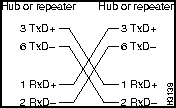



Pin1
In
Out
In/Out
Description
14--17
--
Yes
--
Transmit Data (TxD)
12
Yes
--
--
Transmit Clock (Tx_CLK)2
11
--
Yes
--
Transmit Error (Tx_ER)
13
--
Yes
--
Transmit Enable (Tx_EN)
3
--
Yes
--
MII Data Clock (MDC)
4--7
Yes
--
--
Receive Data (RxD)
9
Yes
--
--
Receive Clock (Rx_CLK)
10
Yes
--
--
Receive Error (Rx_ER)
8
Yes
--
--
Receive Data Valid (Rx_DV)
18
Yes
--
--
Collision (COL)
19
Yes
--
--
Carrier Sense (CRS)
2
--
--
Yes
MII Data Input/Output (MDIO)
22--39
--
--
--
Common (ground)
1, 20, 21, 40
--
--
--
+5.0 volts (V)
1 Any pins not indicated are not used.
2 Tx_CLK and Rx_CLK are generated by the external transceiver.
Parameter
RJ-45
MII
SC-Type
Cable specification
Category 51 UTP2, 22 to 24 AWG3
Category 3, 4, or 5, 150-ohm UTP or STP, or multimode optical fiber
62.5/125 multimode optical fiber
Maximum cable length
--
0.5 m (1.64 ft.) (MII-to-MII cable4)
--
Maximum segment length
100 m (328 ft.) for 100BASE-TX
1 m (3.28 ft.)5 or 400 m (1,312 ft.) for 100BASE-FX
100 m (328 ft.)
Maximum network length
200 m (656 ft)5. (with 1 repeater)
--
200 m (656 ft)5. (with 1 repeater)
1 EIA/TIA-568 or EIA-TIA-568 TSB-36 compliant.
2 Cisco Systems does not supply Category 5 UTP RJ-45 or 150-ohm STP MII cables. Both are available commercially.
3 AWG = American Wire Gauge. This gauge is specified by the EIA/TIA-568 standard.
4 This is the cable between the MII port on the FE port adapter and the appropriate transceiver.
5 This length is specifically between any two stations on a repeated segment.
Parameter
100BASE-FX
100BASE-TX
Data rate (Mbps)
100
100
Signaling method
Baseband
Baseband
Maximum segment length (meters)
100 m between repeaters
100 m between DTE1 and repeaters
Media
SC-type: dual simplex or single duplex for Rx and Tx
RJ-45MII
Topology
Star/Hub
Star/Hub
1 DTE = data terminal equipment.
/ftp/feip-fx
at
ftp.cisco.com
. Detailed information about the latest FEIP microcode images can be found in the ASCII file feip.readme.txt, which is also available via FTP from
ftp.cisco.com
in the directory
/ftp/feip-fx/
. This ASCII file includes information and instructions on how to get the current FEIP microcode image. To access Cisco IOS images and information located in Cisco Connection Online (CIO), refer to the section "Cisco Connection Online" at the end of this publication.
![]()
![]()
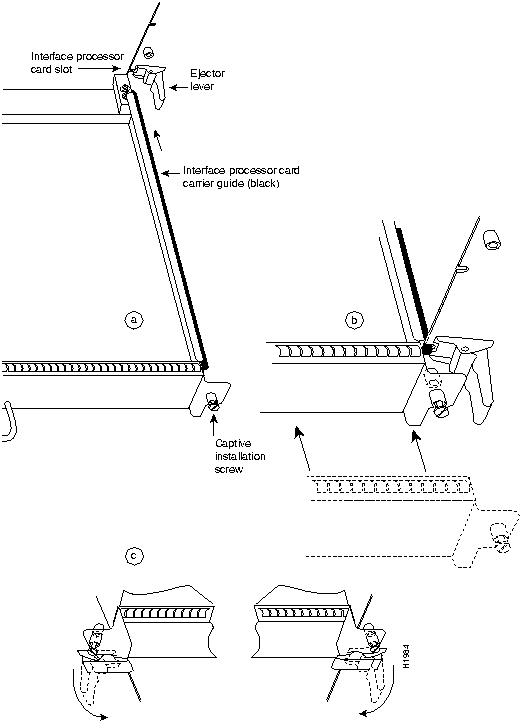
![]()
![]()
![]()
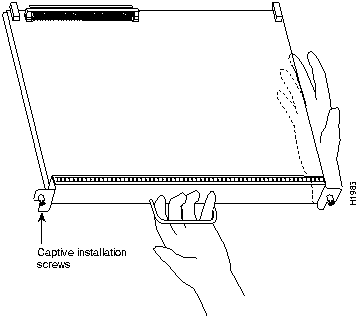
![]()
![]()
![]()

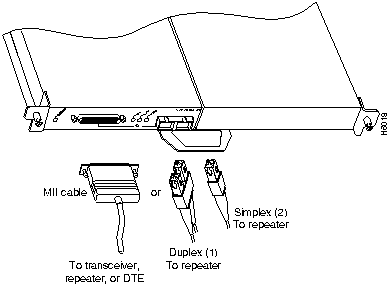
![]()

![]()
Router#
%OIR-6-REMCARD: Card removed from slot 1, interfaces disabled
%LINK-5-CHANGED: Interface FastEthernet2/0, changed state to administratively down
%LINK-5-CHANGED: Interface FastEthernet2/1, changed state to administratively down
Router#
%OIR-6-INSCARD: Card inserted in slot 1, interfaces administratively shut down
%LINK-5-CHANGED: Interface FastEthernet2/0, changed state to up
%LINK-5-CHANGED: Interface FastEthernet2/1, changed state to up
Router#
%OIR-6-INSCARD: Card inserted in slot 3, interfaces administratively shut down
%LINK-5-CHANGED: Interface FastEthernet3/0, changed state to administratively down
%LINK-5-CHANGED: Interface FastEthernet3/1, changed state to administratively down
Router>
enable
Password:
Router#
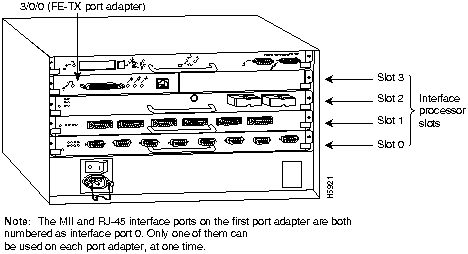
Router# show int
FastEthernet3/0/0 is up, line protocol is up
Hardware is cxBus FastEthernet, address is 0000.0c03.4a3b (bia 0000.0c03.4a3b)
(additional display text omitted)
Router# show interfaces fastethernet 3/0/0
FastEthernet3/0/0 is administratively down, line protocol is down
Hardware is cxBus FastEthernet, address is 0000.0c35.dc16 (bia 0000.0c35.dc16)
Internet address is 1.1.0.64 255.255.0.0
MTU 1500 bytes, BW 100000 Kbit, DLY 100 usec, rely 255/255, load 1/255
Encapsulation ARPA, loopback not set, keepalive not set, hdx, MII
ARP type: ARPA, ARP Timeout 4:00:00
Last input never, output 2:03:52, output hang never
Last clearing of "show interface" counters never
Output queue 0/40, 0 drops; input queue 0/75, 1 drops
5 minute input rate 0 bits/sec, 0 packets/sec
5 minute output rate 0 bits/sec, 0 packets/sec
0 packets input, 0 bytes, 0 no buffer
Received 0 broadcasts, 0 runts, 0 giants
0 input errors, 0 CRC, 0 frame, 0 overrun, 0 ignored, 0 abort
0 watchdog, 0 multicast
0 input packets with dribble condition detected
5 packets output, 805 bytes, 0 underruns
0 output errors, 0 collisions, 4 interface resets, 0 restarts
0 babbles, 0 late collision, 0 deferred
0 lost carrier, 0 no carrier
0 output buffer failures, 0 output buffers swapped out
Router# configure terminal
Enter configuration commands, one per line. End with CNTL/Z.
Router(config)#
Router(config)# interface fastethernet 3/0/0
Router(config-if)# full-duplex
Ctrl-z
Router#
Router# sh int fa 3/0/0
FastEthernet3/0/0 is administratively down, line protocol is down
(display text omitted)
Encapsulation ARPA, loopback not set, keepalive not set, fdx, 100BaseTX
(display text omitted)
Router# config t
Enter configuration commands, one per line. End with CNTL/Z.
Router(config)# int fa 3/0/0
Router(config-if)# no full
Ctrl-z
Router#
Router# sh int fa 3/0/0
FastEthernet3/0/0 is administratively down, line protocol is down
(display text omitted)
Encapsulation ARPA, loopback not set, keepalive not set, hdx, 100BaseTX
(display text omitted)
Router# config t
Enter configuration commands, one per line. End with CNTL/Z.
Router(config)# int fa 3/0/0
Router(config-if)# media-type mii
Ctrl-z
Router#
Router# sh int fa 3/0/0
FastEthernet3/0/0 is administratively up, line protocol is up
(display text omitted)
Encapsulation ARPA, loopback not set, keepalive not set, hdx, MII
(display text omitted)
Router# show version
Cisco Internetwork Operating System Software
IOS (tm) GS Software (GS7-K-M), Version 10.3(5)
Copyright (c) 1986-1995 by cisco Systems, Inc.
Compiled Wed 10-May-95 21:15 by mpo
Image text-base: 0x00001000, data-base: 0x005FE99C
ROM: System Bootstrap, Version 5.3(1), SOFTWARE
ROM: GS Software (GS7-K-M), Version 10.3(5), RELEASE SOFTWARE
Router uptime is 2 hours, 3 minutes
System restarted by reload
System image file is "gs7-k-m", booted via tftp from 1.1.1.2
RP (68040) processor with 16384K bytes of memory.
G.703/E1 software, Version 1.0.
X.25 software, Version 2.0, NET2, BFE and GOSIP compliant.
Bridging software.
1 Silicon Switch Processor.
1 EIP controller (6 Ethernet).
1 FEIP controller (1 Fast Ethernet).
6 Ethernet/IEEE 802.3 interfaces.
1 FastEthernet/IEEE 802.3 interfaces.
128K bytes of non-volatile configuration memory.
4096K bytes of flash memory on embedded flash (in RP1).
Configuration register is 0x0
Router# show controllers cbus
(display text omitted)
FEIP 3, hardware version 2.0, microcode version 10.0
Interface 32 - FastEthernet3/0/0, station addr 0000.0c02.d0cc (bia 0000.0c02.d0cc)
18 buffer RX queue threshold, 25 buffer TX queue limit, buffer size 1520
ift 0000, rql 18, tq 0000 0000, tql 25
Transmitter delay is 0 microseconds
(display text omitted)
Router# show config
Using 1652 out of 130048 bytes
version 10.3(5)
!
hostname Router
!
enable-password hello
!
microcode FEIP flash feip10-0
microcode reload
(display text omitted)
!
interface FastEthernet3/0/0
ip address 1.1.1.1 255.255.255.248
ip route-cache cbus
(display text omitted)
Router# show protocols
Global values:
Internet Protocol routing is enabled
FastEthernet3/0/0 is up, line protocol is up
(display text omitted)
/ftp/feip-fx
at
ftp.cisco.com
. Detailed information about the latest FEIP microcode images can be found in the ASCII file feip.readme.txt, which is also available via FTP from
ftp.cisco.com
in the directory
/ftp/feip-fx/
. This ASCII file includes information and instructions on how to get the current FEIP microcode image.To access Cisco IOS images and information located in Cisco Information Online (CIO), refer to the section "Cisco Connection Online" at the end of this publication.
![]()
Router#
show flash
4096K bytes of flash memory on embedded flash (in RP1).
(note that the RSP has 8 MB of Flash)
file offset length name
[4194304/4194304 bytes free]
(display text omitted)
buffer overflow - xxxx/xxxx
Router#
copy tftp:feip10-1 slot0:feip10-1
20575008 bytes available on device slot0, proceed? [confirm]
Address or name of remote host [1.1.1.1]?
Loading new.image from 1.1.1.1 (via Ethernet1/0): !!!!!!!!!!!!!!!!!!!!!!!!!!!!!!
!!!!!!!!!!!!!!!!!!!!!!!!!!!!!!!!!!!!!!!!!!!!!!!!!!!!!!!!!!!!!!!!!!!!!!!!!!!!!!!!
!!!!!!!!!!!!!!!!!!!!!!!!!!!!!!!!!!!!!!!!!!!!!!!!!!!!!!!!!!!!!!!!!!!!!!!!!!!!!!!!
!!!!!!!!!!!!!!!!!!!!!!!!!!!!!!!!!!!!!!!!!!!!!!!!!!!!!!!!!!!!!!!!!!!!!!!!!!!!!!!!
!!!!!!!!!!!!!!!!!!!!!!!!!!!!!!!!!!!!!!!!!!!!!!!!!!!!!!!!!!!!!!!!!!!!!!!!!!!!!!!!
!!!!!!!!!!!!!!!!!!!!!!!!!!!!!!!!!!!!!!!!!!!!!!![OK - 7799951/15599616 bytes]
CCCCCCCCCCCCCCCCCCCCCCCCCCCCCCCCCCCCCCCCCCCCCCCCCCCCCCCCCCCCCCCCCCCCCCCCCCCCCCCC
CCCCCCCCCCCCCCCCCCCCCCCCCCCCCCCCCCCCCCCCCCCCCCCCCCCCCCCCCCCCCCCCCCCCCCCCCCCCCCCC
CCCCCCCCCCCCCCCCCCCCCCCCCCCCCCCCCCCCCCCCCCCCCCCCCCCCCCCCCCCCCCCCCCCCCCCCCC
Router#
Router#
show flash
4096K bytes of flash memory on embedded flash (in RP1).
(note that the RSP has 8 MB of Flash)
file offset length name
1 0xD0D4 53364 feip10-1
[4085336/4194304 bytes free]
Router#
config t
Enter configuration commands, one per line. End with CNTL/Z.
Router(config)#
microcode feip flash feip10-1
Router#
copy running-config startup-config
Router#
config t
Enter configuration commands, one per line. End with CNTL/Z.
Router(config)#
microcode reload
Router#
show configuration
![]()
http://www.cisco.com.
cco.cisco.com.
ccohelp@cisco.com.
For additional information, contact
ccoteam@cisco.com.
tac@cisco.com.
To obtain general information about Cisco Systems, Cisco products, or upgrades, contact 800 553-6387, 408 526-7208, or
csrep@cisco.com.

![]()
![]()
![]()
![]()
![]()
![]()
![]()
![]()